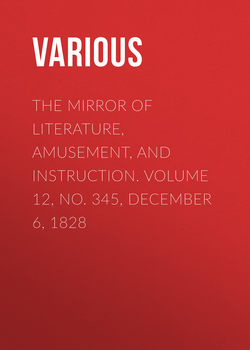Читать книгу The Mirror of Literature, Amusement, and Instruction. Volume 12, No. 345, December 6, 1828 - Various - Страница 4
The Cosmopolite
ОглавлениеDANCING
(For the Mirror.)
Dancing is defined to be "to move in measure; to move with steps correspondent to the sound of instruments." But there are other species of dancing—as
—–for three long months
To dance attendance for a word of audience:
and to dance with pain, or when, as Lord Bacon says, "in pestilences, the malignity of the infecting vapour danceth the principal spirits." The Chorea S. Viti, or St. Vitus's Dance is another variation, said to have once prevailed extensively, and to have been cured by a prayer to this saint! whose martyrdom is commemorated on June 15. It may not be generally known that a person afflicted with this species of dancing can run, although he cannot walk or stand still. Another and a more agreeable species is to lead the dance, an unjust usurpation which is practised in a thousand other places beside the ball-room.
According to the mythologists, (authorities always quotable, and nobody knows why,) the Curetes or Corybantes, a people of Crete, who were produced from rain, first invented the dance to amuse the infant Jupiter—with what success he danced we know not, for when a year old he waged war against the Titans, and then his dancing days must have terminated.
A history of dancing is, however, not to our purpose; but a few of its eccentricities. It occurs in the customs of all people, either as a recreation or as a religious ceremony—held in contempt by some, and in esteem by others. David danced before the ark; the daughters of Shiloh danced in a solemn yearly festival; and the Israelites, (good judges) danced round the golden calf.
The ancients had a peculiar penchant for dancing, whether in person or by animals; and the feats of the latter distance all the wretched efforts of the bears, dogs, and horses of our days. The attempts of Galba to amuse the Roman people throw into the shade all the peace-rejoicings and illuminations of St. James's and the Green Parks. Suetonius, Seneca, and Pliny tell us of elephants in their time that were taught to walk the rope, backwards and forwards, up and down, with the agility of an Italian rope-dancer. Such was the confidence reposed in the docility and dexterity of the animal, that a person sat upon an elephant's back, while he walked across the theatre upon a rope, extended from the one side to the other. Lipsius, who has collected these testimonies, thinks them too strong to be doubted—perhaps even stronger than the rope. Scaliger corroborates all of them; Busbequius saw an elephant dance a pas seul at Constantinople; and Suetonius tells us of twelve elephants, six male and six female, who were clothed like men and women, and performed a country dance, in the reign of Tiberius. In later times, horses have been taught to dance. In the carousals of Louis XIII. there were dances of horses; and in the 13th century, some rode a horse upon a rope. All this eclipses the puny modern feats of Astley and Ducrow.4
4
Miraculous dancing is not, however, confined to animals; for William of Malmesbury gravely relates an instance of 15 young women and 18 young men who (by the anathema of a priest) continued dancing a whole year, and wore the earth so much, that, by degrees, they sunk midway into the earth!
